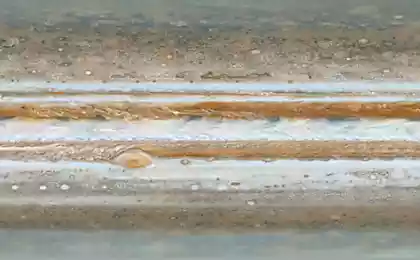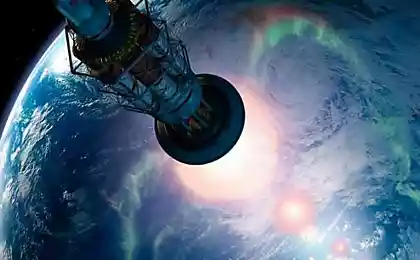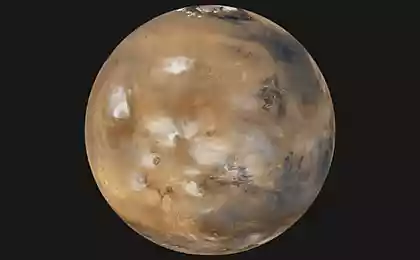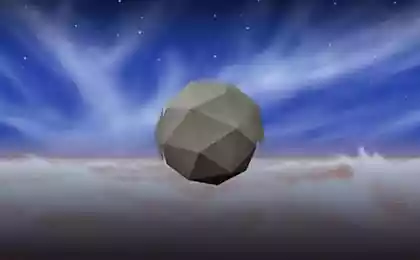705
Jupiter is what it is
In the course of those about Mars, Venus and Saturn!
Jupiter - the fifth distance from the Sun and the first largest planet in the solar system. The planet has been known since ancient times and is named after the Roman god Jupiter, the Greek Zeus analog. It refers to the type of gas giants. When viewed from Earth, the star can reach Velična to -2.8, making it the brightest object in the night sky after the Moon and Venus (however, at certain points in its orbit Mars could be a bit brighter Jupiter).

2
Jupiter's mass is more than 2 times the total mass of all the other planets of the solar system, 318 times - the mass of Earth and is only 1,000 times smaller than the mass of the sun. If Jupiter was about 70 times more massive, it could become a star. The density of Jupiter is approximately equal to the density of the Sun and the Earth's density is considerably inferior.

3
All that we can observe on Jupiter - are clouds of the upper layer of the atmosphere. The giant planet is composed primarily of gas and has no solid surface familiar to us.

4
Jupiter is composed mainly of hydrogen and helium. Under the clouds is a layer depth of 7-25 thousand. Km, in which hydrogen gradually changes its state from gas to liquid with increasing pressure and temperature (6000 ° C). Clear boundary separating hydrogen gas from a liquid, apparently, does not exist. It should look like a continuous boiling of the global ocean of hydrogen.
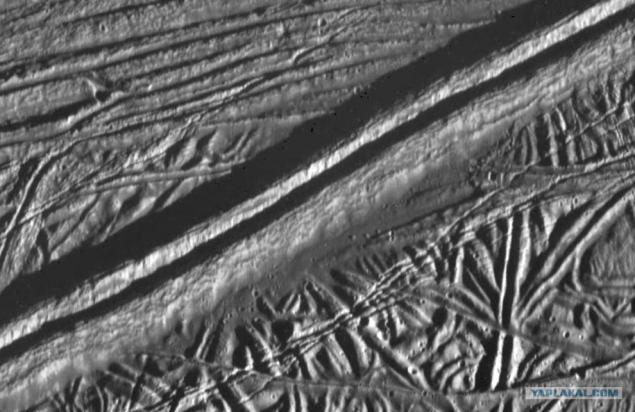
5
Scientists believe that Jupiter has a solid rocky core consisting of heavy elements (heavier than helium). Its size - 15-30 thousand. Km in diameter, the core has a high density. According to theoretical calculations, the core temperature of the planet - about 20, 000 ° C, and the pressure - 30-100 million. Atmospheres.

6
The speed of the winds on Jupiter can exceed 600 km / h. The circulation of the atmosphere is determined by two main factors. First, the rotation of Jupiter's equatorial and polar regions is not the same, so the atmospheric patterns are drawn in the band encircling the planet. Secondly, there is a temperature circulation due to heat generated from the depths. Unlike the Earth (where the circulation of the atmosphere is due to the difference of solar heating in the equatorial and polar regions) on Jupiter effects of solar radiation on the temperature circulation slightly.
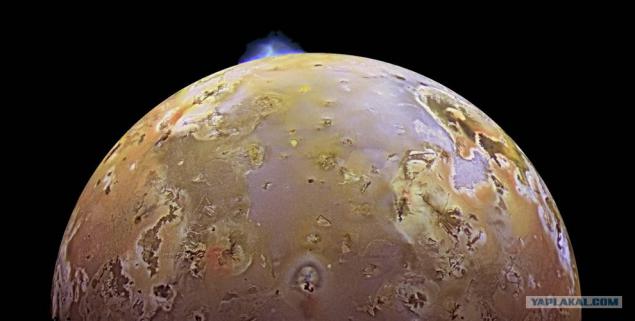
7
Jupiter has a strong magnetic field; dipole axis inclined to the axis of rotation by 10 °. Its polarity reverse polarity magnetic field of the earth.

8
Great Red Spot - an oval formation of varying sizes, located in the southern tropics. Currently, it has a size of 15 × 30 thousand km. (Significantly greater than the dimensions of the Earth), and 100 years ago observers celebrated 2 times large. Sometimes it is not very clearly visible. Great Red Spot - a unique long-lived giant hurricane (anticyclone), a substance which is rotated counterclockwise and makes a full rotation every six Earth days. It is characterized by upward trends in the atmosphere. Clouds are located above it, and the temperature of lower than in the neighboring areas.

9
Jupiter has faint rings found during the passage of Jupiter by "Voyager-1" in 1979. The ring surrounding the planet is perpendicular to the equator, located at an altitude of 55,000 km from the atmosphere. There are two main ring and one, very subtle, inner, with a characteristic orange color. The thickness of the rings seem to be no more than a few kilometers. The rings are composed mainly of dust and small pieces, reflecting the sun's rays are bad, but because they are difficult to see. From the Earth ring can be seen when viewed in the infrared range. According to the research "Galileo" it was concluded that the source of replenishment of the rings are small moons of Jupiter.

10
Jupiter, NASA's only been studied.
In 1973 and 1974 passed by Jupiter "Pioneer 10" and "Pioneer 11" at a distance (from the cloud) 132 thous. Km and 43 th. Km, respectively. Devices delivered several hundred pictures (low resolution) and the Galilean moons of the planet for the first time measured the basic parameters of the magnetic field and the magnetosphere of Jupiter.
In 1979, it flew near Jupiter "Voyager" (at a distance of 207 thousand. Km and 570 thousand. Km). For the first time were obtained high-resolution images of the planet and its satellites (total received about 33 thousand. Pictures), were discovered Jupiter's rings; The handset also passed a number of other valuable data, including information on the chemical composition of the atmosphere, magnetosphere, data, and so on. d.

11
In 1992, he passed by the planet "Ulysses" at a distance of 900 thousand. Km. The unit had a measurement of the magnetosphere of Jupiter ("Ulysses" is designed to study the Sun and has no camera).
From 1995 to 2003, in the orbit of Jupiter was "Galileo". With this mission has been received a lot of new data. In particular, the lander for the first time studied the planet's atmosphere gas inside. A lot of high-resolution images and data from other measurements allowed to study in detail the dynamics of Jupiter's atmospheric processes, as well as to make new discoveries about his companions. Main dish "Galileo" is not opened, so that the data stream was only 1% of the potentially possible (however, all of the major objectives of the mission have been achieved).
In 2000, it flew past Jupiter "Cassini". He made a series of photographs of the planet with a record (for large images) resolution and new data on the Io plasma torus. By snapshots "Cassini" were made the most detailed to date colored "map" of Jupiter, where the size of the smallest details is 120 km. In addition, it was made a unique experiment to measure the planet's magnetic field simultaneously with two points ("Cassini" and "Galileo»).
February 28, 2007 on the way to Pluto in the vicinity of Jupiter makes gravity assist device "New Horizons." Spend photography planets and satellites (see. Some shots), the data in the volume of 33 Gigabits transferred to Earth to obtain new information. [1]
In 2010, the planned launch vehicle "Juno", which should reach the orbit of Jupiter and conduct detailed studies of the planet.
In the 2010s it is planned interplanetary mission to study the Galilean satellites.

12
Currently, the presence of life on Jupiter seems unlikely due to the low concentration of water in the atmosphere and lack of hard surfaces. In 1970 the American astronomer Carl Sagan spoke on the possibility of the existence in the upper atmosphere of Jupiter ammonia-based life [2]. It should be noted that even at a shallow depth in the Jupiter atmosphere temperature and the density is sufficiently high and the possibility at least of chemical evolution can not be excluded, since the rate and probability of the chemical reactions are favorable. However, there can exist on Jupiter and water and hydrocarbon life-containing clouds of water vapor of the atmosphere temperature and pressure is also very favorable

13
In July 1992, close to Jupiter Comet. She walked a distance of about 15,000 kilometers from the cloud top and the powerful gravitational influence of the giant planet tore her core of 17 major parts. This comet swarm was found on Mount Palomar Observatory spouses Carolyn and Eugene Shoemaker and amateur astronomer David Levy. In 1994, the next rapprochement with Jupiter, all the fragments of a comet crashed into the planet's atmosphere at great speed - about 64 kilometers per second. This grand cosmic cataclysm was observed both from Earth and from space assets, in particular through the Space Telescope "Hubble", infrared IUE satellite and interplanetary space station "Galileo". The fall was accompanied by nuclear interesting atmospheric effects, such as auroras, black spots in areas falling comet nucleus, climatic changes.

14
In the atmosphere of Jupiter observed lightning, the power of which is three orders higher than the earth, and the aurora. In addition, the orbiting telescope "Chandra" discovered the source of pulsed X-ray radiation (X-ray called great spot), whose causes are still a mystery.

15
The measurements were made with both the Earth and the probes, have revealed that the energy released by Jupiter, mainly as infrared radiation, about 1, 5 times more than it receives from the sun. It is clear that Jupiter has significant reserves of thermal energy, formed at the time of the collapse of matter in the formation of the planet. It is generally believed that in the depths of Jupiter are still very hot - about 30,000 ° K.

Source:
Jupiter - the fifth distance from the Sun and the first largest planet in the solar system. The planet has been known since ancient times and is named after the Roman god Jupiter, the Greek Zeus analog. It refers to the type of gas giants. When viewed from Earth, the star can reach Velična to -2.8, making it the brightest object in the night sky after the Moon and Venus (however, at certain points in its orbit Mars could be a bit brighter Jupiter).

2
Jupiter's mass is more than 2 times the total mass of all the other planets of the solar system, 318 times - the mass of Earth and is only 1,000 times smaller than the mass of the sun. If Jupiter was about 70 times more massive, it could become a star. The density of Jupiter is approximately equal to the density of the Sun and the Earth's density is considerably inferior.

3
All that we can observe on Jupiter - are clouds of the upper layer of the atmosphere. The giant planet is composed primarily of gas and has no solid surface familiar to us.

4
Jupiter is composed mainly of hydrogen and helium. Under the clouds is a layer depth of 7-25 thousand. Km, in which hydrogen gradually changes its state from gas to liquid with increasing pressure and temperature (6000 ° C). Clear boundary separating hydrogen gas from a liquid, apparently, does not exist. It should look like a continuous boiling of the global ocean of hydrogen.

5
Scientists believe that Jupiter has a solid rocky core consisting of heavy elements (heavier than helium). Its size - 15-30 thousand. Km in diameter, the core has a high density. According to theoretical calculations, the core temperature of the planet - about 20, 000 ° C, and the pressure - 30-100 million. Atmospheres.

6
The speed of the winds on Jupiter can exceed 600 km / h. The circulation of the atmosphere is determined by two main factors. First, the rotation of Jupiter's equatorial and polar regions is not the same, so the atmospheric patterns are drawn in the band encircling the planet. Secondly, there is a temperature circulation due to heat generated from the depths. Unlike the Earth (where the circulation of the atmosphere is due to the difference of solar heating in the equatorial and polar regions) on Jupiter effects of solar radiation on the temperature circulation slightly.

7
Jupiter has a strong magnetic field; dipole axis inclined to the axis of rotation by 10 °. Its polarity reverse polarity magnetic field of the earth.

8
Great Red Spot - an oval formation of varying sizes, located in the southern tropics. Currently, it has a size of 15 × 30 thousand km. (Significantly greater than the dimensions of the Earth), and 100 years ago observers celebrated 2 times large. Sometimes it is not very clearly visible. Great Red Spot - a unique long-lived giant hurricane (anticyclone), a substance which is rotated counterclockwise and makes a full rotation every six Earth days. It is characterized by upward trends in the atmosphere. Clouds are located above it, and the temperature of lower than in the neighboring areas.

9
Jupiter has faint rings found during the passage of Jupiter by "Voyager-1" in 1979. The ring surrounding the planet is perpendicular to the equator, located at an altitude of 55,000 km from the atmosphere. There are two main ring and one, very subtle, inner, with a characteristic orange color. The thickness of the rings seem to be no more than a few kilometers. The rings are composed mainly of dust and small pieces, reflecting the sun's rays are bad, but because they are difficult to see. From the Earth ring can be seen when viewed in the infrared range. According to the research "Galileo" it was concluded that the source of replenishment of the rings are small moons of Jupiter.

10
Jupiter, NASA's only been studied.
In 1973 and 1974 passed by Jupiter "Pioneer 10" and "Pioneer 11" at a distance (from the cloud) 132 thous. Km and 43 th. Km, respectively. Devices delivered several hundred pictures (low resolution) and the Galilean moons of the planet for the first time measured the basic parameters of the magnetic field and the magnetosphere of Jupiter.
In 1979, it flew near Jupiter "Voyager" (at a distance of 207 thousand. Km and 570 thousand. Km). For the first time were obtained high-resolution images of the planet and its satellites (total received about 33 thousand. Pictures), were discovered Jupiter's rings; The handset also passed a number of other valuable data, including information on the chemical composition of the atmosphere, magnetosphere, data, and so on. d.

11
In 1992, he passed by the planet "Ulysses" at a distance of 900 thousand. Km. The unit had a measurement of the magnetosphere of Jupiter ("Ulysses" is designed to study the Sun and has no camera).
From 1995 to 2003, in the orbit of Jupiter was "Galileo". With this mission has been received a lot of new data. In particular, the lander for the first time studied the planet's atmosphere gas inside. A lot of high-resolution images and data from other measurements allowed to study in detail the dynamics of Jupiter's atmospheric processes, as well as to make new discoveries about his companions. Main dish "Galileo" is not opened, so that the data stream was only 1% of the potentially possible (however, all of the major objectives of the mission have been achieved).
In 2000, it flew past Jupiter "Cassini". He made a series of photographs of the planet with a record (for large images) resolution and new data on the Io plasma torus. By snapshots "Cassini" were made the most detailed to date colored "map" of Jupiter, where the size of the smallest details is 120 km. In addition, it was made a unique experiment to measure the planet's magnetic field simultaneously with two points ("Cassini" and "Galileo»).
February 28, 2007 on the way to Pluto in the vicinity of Jupiter makes gravity assist device "New Horizons." Spend photography planets and satellites (see. Some shots), the data in the volume of 33 Gigabits transferred to Earth to obtain new information. [1]
In 2010, the planned launch vehicle "Juno", which should reach the orbit of Jupiter and conduct detailed studies of the planet.
In the 2010s it is planned interplanetary mission to study the Galilean satellites.

12
Currently, the presence of life on Jupiter seems unlikely due to the low concentration of water in the atmosphere and lack of hard surfaces. In 1970 the American astronomer Carl Sagan spoke on the possibility of the existence in the upper atmosphere of Jupiter ammonia-based life [2]. It should be noted that even at a shallow depth in the Jupiter atmosphere temperature and the density is sufficiently high and the possibility at least of chemical evolution can not be excluded, since the rate and probability of the chemical reactions are favorable. However, there can exist on Jupiter and water and hydrocarbon life-containing clouds of water vapor of the atmosphere temperature and pressure is also very favorable

13
In July 1992, close to Jupiter Comet. She walked a distance of about 15,000 kilometers from the cloud top and the powerful gravitational influence of the giant planet tore her core of 17 major parts. This comet swarm was found on Mount Palomar Observatory spouses Carolyn and Eugene Shoemaker and amateur astronomer David Levy. In 1994, the next rapprochement with Jupiter, all the fragments of a comet crashed into the planet's atmosphere at great speed - about 64 kilometers per second. This grand cosmic cataclysm was observed both from Earth and from space assets, in particular through the Space Telescope "Hubble", infrared IUE satellite and interplanetary space station "Galileo". The fall was accompanied by nuclear interesting atmospheric effects, such as auroras, black spots in areas falling comet nucleus, climatic changes.

14
In the atmosphere of Jupiter observed lightning, the power of which is three orders higher than the earth, and the aurora. In addition, the orbiting telescope "Chandra" discovered the source of pulsed X-ray radiation (X-ray called great spot), whose causes are still a mystery.

15
The measurements were made with both the Earth and the probes, have revealed that the energy released by Jupiter, mainly as infrared radiation, about 1, 5 times more than it receives from the sun. It is clear that Jupiter has significant reserves of thermal energy, formed at the time of the collapse of matter in the formation of the planet. It is generally believed that in the depths of Jupiter are still very hot - about 30,000 ° K.

Source:
















